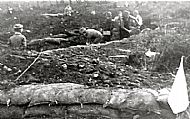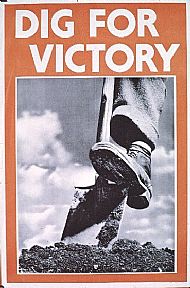Sandy's Blog
Cromarty's Wartime Home Front
by Casagrandeblog - 14:18 on 12 June 2013
Last week our focus was on Cromarty at War. On Thursday morning, around twenty of us clambered around the slopes of the Sutor looking at the wartime gun emplacements etc., and in the afternoon about two dozen folk gathered in the Victoria Hall to share wartime memories, sitting beneath the banners that John McNaught made back in 2005 showing Cromarty individuals who had lived through World War II. That project was funded by a lottery grant called ‘Home Front Recall’, designed to celebrate the fortitude of the ‘non-combatants’ who suffered the privations and dangers of the times.
Eric Malcolm’s book, The Cromarty We Knew, gives a very full picture of the Cromarty Home Front. Preparations for war began in 1937, when press adverts sought volunteers to join the Air Raid Wardens Service (ARP), and the Cromarty Police Sergeant, Sergeant Duff, was sent on a course on anti-gas precautions. He in turn, lectured to the general public. The local GP, Dr Gillanders, organised a series of classes in the Hugh Miller Institute on First Aid. Clearly there was a real expectation that local people might be bombed, gassed or both. The fact that Cromarty and Invergordon were exempted from the national requirement to take in evacuee children from the cities, shows that the authorities saw this area as being in the front line.
Hitler invaded Poland on 1st September 1939, and the previous evening Eric went with Rob Ritchie in his lorry to Invergordon to collect Cromarty’s gas masks. That weekend saw feverish activity throughout the town as blackout curtains were devised, sticky tape applied to the school windows and trenches hurriedly dug at the foot of the Denny to serve as air raid shelters. When the pupils returned to school, they were put to work digging their own trenches on the Links below the school. These trenches were later lined, roofed and equipped with seats. The third official air raid shelter was the tunnel to Cromarty House.
previous evening Eric went with Rob Ritchie in his lorry to Invergordon to collect Cromarty’s gas masks. That weekend saw feverish activity throughout the town as blackout curtains were devised, sticky tape applied to the school windows and trenches hurriedly dug at the foot of the Denny to serve as air raid shelters. When the pupils returned to school, they were put to work digging their own trenches on the Links below the school. These trenches were later lined, roofed and equipped with seats. The third official air raid shelter was the tunnel to Cromarty House.
Eric himself was an ARP Messenger (he had a bike), and for the first week of the war he slept fully clothed on a camp bed in the Town Clerk’s office, ready for action. After a week with no invasion, air raids or gas attacks, people calmed down and Eric returned to his own bed.
Life however was far from normal. Food and clothes were rationed, blackout restrictions imposed, and waste paper and scrap metal were saved and collected from shops and houses in the town. One of the teachers at Cromarty School designed a device to crush tin cans and this was kept in the old slaughterhouse beside the ferry slipway. Growing your own food was encouraged. The schoolchildren had allotments at the west end of the Links (the seeds came from the USA), while the adult allotments were on the High Street, west of the church. Even the Victoria Park was dug up for tatties.
Food and clothes were rationed, blackout restrictions imposed, and waste paper and scrap metal were saved and collected from shops and houses in the town. One of the teachers at Cromarty School designed a device to crush tin cans and this was kept in the old slaughterhouse beside the ferry slipway. Growing your own food was encouraged. The schoolchildren had allotments at the west end of the Links (the seeds came from the USA), while the adult allotments were on the High Street, west of the church. Even the Victoria Park was dug up for tatties.
And, of course, Cromarty had its Home Guard. Fans of ‘Dad’s Army’ won’t be surprised to learn that Cromarty Home Guard had only one gun. According to Billy Fraser, who used to live in Miller Lane, off Church Street, his father got the gun because he had seen active service in World War I. Just as well we were never invaded!
Add your comment
